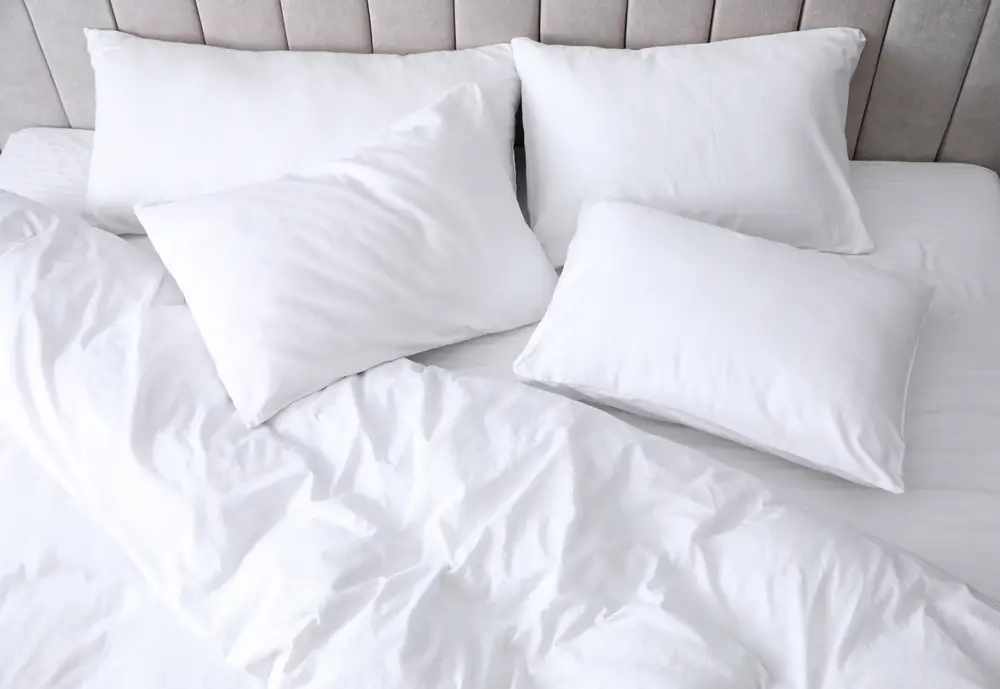In the serenity of slumber, a potentially harmful host may lie beside you: your pillow.
Pillows, often overlooked in discussions about indoor health risks, can harbor a slew of toxic chemicals and allergens that may contribute to various health issues, including respiratory problems, allergic reactions, and even cancer.
This article aims to shed light on the potential dangers lurking within your pillows, discuss their associated health implications, and propose safer alternatives for a healthier sleep environment.
The Toxic Brew: Common Chemicals Found in Pillows
Explore the hidden components that make up the pillows we rest our heads on, shedding light on the common chemicals found within them and their potential impact on our health and well-being.
Flame Retardants
Flame retardants like Polybrominated diphenyl ethers (PBDEs) are commonly found in pillows. Research has associated these chemicals with numerous health issues, including hormonal disruption, fertility problems, and even cancer. The insidious nature of PBDEs is that they are stubbornly persistent and tend to bioaccumulate, meaning their concentration can build up in your body over time. [1,2]
Pesticides
The fabrics used in pillows, especially those made from conventional cotton, often retain pesticide residues. These pesticides can potentially disrupt hormone functions, induce neurodevelopmental problems, and trigger cancer.
Formaldehyde
Formaldehyde, a potent carcinogen as recognized by the International Agency for Research on Cancer (IARC), is prevalent in textiles, including pillows. Off-gassing of formaldehyde from pillows may lead to eye, nose, and throat irritation, as well as respiratory problems. [3]
Perfumes and Deodorants
To disguise the chemical smells of off-gassing toxins, many pillows are treated with perfumes and deodorants. However, these fragrances can exacerbate symptoms such as headaches and sore throats, especially in fragrance-sensitive individuals. [4]
Polyester
Polyester, a petroleum-derived plastic used in pillow filling, can emit harmful chemicals when it breaks down. This may cause respiratory issues and skin irritation.
Dust Mites, Molds, and Microbes
Pillows can be a breeding ground for tiny creatures like dust mites, which thrive in warm, humid environments and can trigger allergies and asthma attacks. Moreover, pillows can harbor molds, mildews, fungi, and bacteria, leading to various health issues, including respiratory infections, allergic reactions, headaches, and fatigue.
Ticks, Fleas, and Bedbugs
Ticks, fleas, and bedbugs can find their way into pillows, especially second-hand ones or those stored in unclean environments. These pests can lead to health problems, including Lyme disease and Rocky Mountain spotted fever.
The VOC Effect: How Pillow Toxins Impact Your Health
Many toxins in pillows are classified as volatile organic compounds (VOCs). They off-gas into the air, and you unknowingly breathe them in while sleeping. The potential health effects from chronic exposure to these VOCs and other pillow-borne chemicals are myriad:
- Headaches
- Liver damage
- Brain fog
- Asthma
- Eye, throat, and nose irritation
- Nausea and vomiting
- Cancer
- Lung issues
- Thyroid problems
- Dizziness
- Central nervous system damage
- Kidney damage

Recognizing the Offenders: Types of Pillows to Avoid
Let’s delve into the world of pillows and highlight the various types to steer clear of.
Memory Foam Pillows
These popular pillows usually harbor higher levels of toxic chemicals. As these chemicals degrade, they disperse in the air through a process known as “off-gassing.” [5,6]
Down/Feather Pillows
Some studies have discovered alarmingly high levels of glue in down and feather pillows used to hold the filling together. This could pose potential health risks. [7]
Synthetic Latex Pillows
Although potentially less harmful than memory foam pillows, synthetic latex pillows can still emit VOCs due to the presence of polyurethane foam and other synthetic materials. [8]
Sleeping Safe: Steps for a Healthier Slumber
To safeguard against the hidden dangers in your pillow, consider these steps:
Choose Natural and Organic Materials
Opt for pillows made from natural and organic materials like organic cotton, wool, or kapok. These materials have lower chemical content and offer a healthier sleep environment.
Look for Certifications
Check for certifications such as Global Organic Textile Standard (GOTS), Oeko-Tex Standard 100, or Greenguard Gold. These certifications guarantee that the product has been rigorously tested for harmful substances and meets strict safety criteria.
Regularly Wash and Replace Your Pillow
Routine washing can help minimize the build-up of dust mites, mold, and bacteria. Experts recommend replacing your pillow every 1-2 years to maintain optimal hygiene and support.
Invest in Pillow Protectors
Pillow protectors guard against allergens, dust mites, and other contaminants, thus extending your pillow’s lifespan.
Maintain a Clean Bedroom Environment
Regular vacuuming, bedding washing, and room airing can decrease the build-up of dust, allergens, and other irritants.
Exercise Caution With Second-Hand or Stored Pillows
Inspect and clean second-hand or long-stored pillows thoroughly before use to avoid potential infestation by ticks, fleas, and bedbugs.
Educate Yourself on Pillow Materials and Manufacturing Processes
Understanding the materials used in your pillows and their manufacturing processes allows you to make informed decisions when purchasing new pillows.
Ventilate Your Bedroom
Letting fresh air into your bedroom can reduce the concentration of VOCs and other potential pollutants in the indoor air.
Consider Hypoallergenic Pillows
If you suffer from allergies or asthma, hypoallergenic pillows may be a suitable choice as they are designed to minimize the presence of allergens.
Healthier Pillow Alternatives: Brands and Options
When choosing a healthier pillow, here are some brands that offer eco-friendly and less toxic options:
- Avocado Green Mattress: They offer GOTS-certified organic cotton and GOLS-certified organic latex pillows.
- Coyuchi: This brand has a selection of organic pillows, including cotton, wool, and kapok options.
- White Lotus Home: This brand offers organic cotton, wool, and natural latex pillows, with a choice of kapok or buckwheat fillings.
- Birch Living: Their organic pillow contains GOTS-certified cotton, natural latex, and eco-INSTITUT-certified wool.
By becoming aware of the potential hazards lurking in our pillows and making more informed choices, we can create safer sleep environments for ourselves and our families. After all, a good night’s sleep should also be a healthy one.

My Personal RX
As a health practitioner, I strongly believe in an all-encompassing approach to creating a healthier, less toxic environment for you and your family. While choosing healthier pillows and bedding is a great start, it’s also essential to address other sources of toxic exposure in your daily life.
- Opt for Organic Food: Consuming organic food can help you avoid harmful pesticides and GMOs. Research shows that organic foods have a lower pesticide residue compared to conventionally grown produce.
- Choose Clean Personal Care Products: Many cosmetics and personal care products contain potentially harmful ingredients. Look for products labeled as “paraben-free,” “sulfate-free,” or “phthalate-free,” and check the Environmental Working Group’s Skin Deep Database to make informed choices.
- Invest in Non-Toxic Furnishing: Furnishings like couches, mattresses, and carpets can off-gas VOCs. Look for furnishings that are labeled as low-VOC or VOC-free.
- Take my Liver Support Supplements: Our liver is the primary organ responsible for detoxifying the body. Taking our Liver Support supplement can help facilitate regular detoxification, particularly from environmental toxins and pesticides in our food supply that are almost impossible to avoid.
- Learn More From My Toxic Guide: I’ve created a comprehensive Toxic Guide to help you better understand the toxins you are exposed to on a daily basis and how to avoid them. Download a free copy to start your journey to a healthier, less toxic lifestyle.
Remember, reducing your exposure to toxins is a journey and not a destination. Start where you can, do what you can, and over time, these small changes can add up to a significant impact on your health and well-being.

- Singh V, Cortes-Ramirez J, Toms LM, Sooriyagoda T, Karatela S. Effects of Polybrominated Diphenyl Ethers on Hormonal and Reproductive Health in E-Waste-Exposed Population: A Systematic Review. Int J Environ Res Public Health. 2022;19(13):7820. Published 2022 Jun 25. https://doi.org/10.3390/ijerph19137820
- Allen JG, Gale S, Zoeller RT, Spengler JD, Birnbaum L, McNeely E. PBDE flame retardants, thyroid disease, and menopausal status in U.S. women. Environ Health. 2016;15(1):60. Published 2016 May 24. https://doi.org/10.1186/s12940-016-0141-0
- IARC Working Group on the Evaluation of Carcinogenic Risks to Humans (2006). Formaldehyde, 2-butoxyethanol and 1-tert-butoxypropan-2-ol. IARC monographs on the evaluation of carcinogenic risks to humans, 88, 1–478. https://www.ncbi.nlm.nih.gov/books/NBK326468/
- Fornazieri MA, Neto AR, de Rezende Pinna F, et al. Olfactory symptoms reported by migraineurs with and without auras. Headache. 2016;56(10):1608-1616. https://doi.org/10.1111/head.12973
- Beckett EM, Miller E, Unice K, Russman E, Pierce JS. Evaluation of volatile organic compound (VOC) emissions from memory foam mattresses and potential implications for consumer health risk. Chemosphere. 2022;303(Pt 1):134945. https://doi.org/10.1016/j.chemosphere.2022.134945
- Noyed, D., & Noyed, D. (2022). Off-gassing. Sleep Foundation. https://www.sleepfoundation.org/research-methodology/off-gassing
- Kawada T, Kuroyanagi J, Okazaki F, et al. An Integrative Evaluation Method for the Biological Safety of Down and Feather Materials. Int J Mol Sci. 2019;20(6):1434. Published 2019 Mar 21. https://doi.org/10.3390/ijms20061434
- Oz K, Merav B, Sara S, Yael D. Volatile Organic Compound Emissions from Polyurethane Mattresses under Variable Environmental Conditions. Environ Sci Technol. 2019;53(15):9171-9180. https://doi.org/10.1021/acs.est.9b01557




















